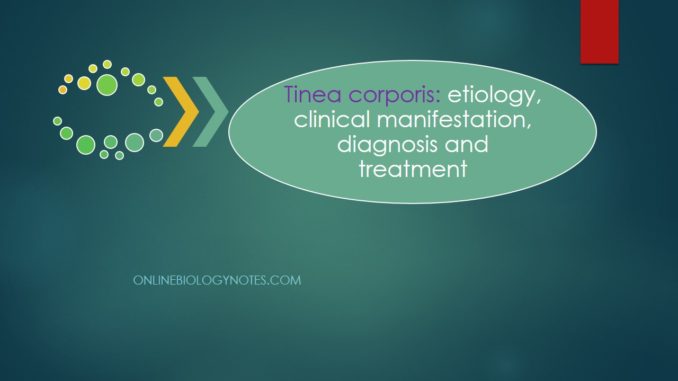
What is Tinea corporis?
- The term tinea corporis refers to dermatophyte infections of the trunk, legs and arms, except the groin, hands and feet.
- It is characterized by either inflammatory or noninflammatory lesions on glabrous skin.
- Geographical distribution:
- It is distributed worldwide however, it is mostly prevalent in tropical and sub-tropical regions.
Epidemiology:
- Etiological agents:
- Epidermophyton floccosum and many species of Trichophyton and Microsporum are causative organisms of Tinea corporis.
- Infection with anthropophilic species, such as E. floccosum or T. rubrum, often follows spread from another infected body site, such as the feet.
- Tinea corporis caused by T. tonsurans is seldom observed in children with tinea capitis and their close contacts.
- Tinea corporis can also occur following contact with infected household pets or farm animals.
- Less commonly, it results from contact with wild animals or contaminated soil.
- Microsporum canis is a common cause for human infection, and Trichophyton verrucosum infection is frequent in rural districts.
- Tinea corporis is more common among individuals who are in regular contact with animals or with the soil.
- Human-to-human transmission of infection with geophilic or zoophilic species is uncommon.
Clinical manifestations of Tinea corporis:
- Tinea corporis may affect any body site, but infections with zoophilic species are more likely to occur on exposed parts such as the face, neck and arms.
- Patients may complain of mild pruritus.
- The clinical manifestations are variable, depending on the species of fungus involved and the extent of progression.
- i) Lesion:
- In typical cases, round scaling lesions which are dry, erythematous and clearly circumscribed are seen.
- The fungus is more active at the margin of the lesions and hence this is more erythematous than the middle, which tends to heal earlier.
- As the first ring of advancing infection continues to spread outwards, it may become surrounded by one or more concentric rings or arcuate patterns.
- Adjacent lesions may fuse producing gyrate patterns.
- In some instances, particularly when a zoophilic dermatophyte is involved, the lesion can become indurated and pustular.
- The lesions of tinea corporis are often more extensive but less obvious in immunosuppressed individuals.
Differential diagnosis of Tinea corporis:
- Tinea corporis can be difficult to distinguish from other causes of erythematous, scaling skin lesions such as discoid eczema, impetigo, psoriasis and discoid lupus erythematosus.
- Thus, laboratory tests should be performed in any patient with skin lesions of undetermined origin.
lab diagnosis of Tinea corporis
- Specimens:
- Specimens should be collected from the raised border of the lesion by scraping outwards with a blunt scalpel held perpendicular to the skin.
- If vesicles are present, the entire top should be submitted for examination.
- Microscopy:
- The branching hyphae is a characteristic of a dermatophyte infection which must be revealed during direct microscopic examination.
- Culture:
- Isolation of the aetiological agent in culture will allow the species of fungus engaged to be determined.
- This will give information as to the source of the infection and support in the selection of appropriate treatment.
Treatment of Tinea corporis
- Topical antifungal preparations are the treatment of choice for localized lesions.
- Numerous imidazole compounds (including bifonazole, clotrimazole, econazole, isoconazole, miconazole, oxiconazole, sulconazole, terconazole and tioconazole) and two allylamine compounds (naftifine and terbinafine) are available in different countries in a number of topical formulations.
- All provide similar high cure rates (70-100%) and side- effects are unusual.
- The drugs should be taken morning and evening upto 2-4 weeks.
- After the clearation of lesions, treatment should be continued for at least 1 week and the medication should be applied at least 3 cm beyond the advancing margin of the lesion.
- Oral treatment is recommended if the lesions are extensive or the patient fails to respond to topical preparations.
- Itraconazole (100mg/day for 2 weeks) and terbinafine (250mg/day for 2-4 weeks) have proved more effective than griseofulvin (10mg/kg per day for 4-6 weeks).
Prevention:
- For the prevention of spreading or recurrence of zoophilic tinea corporis, it is essential to recognize potential sources of infection and, in the case of household pets, take the animal for treatment of suspected dermatophytosis.
- Infection with anthropophilic species, such as T. rubrum, sometimes follows spread from another infected body site, such as the scalp, feet, hands or nails.
- These sites should be examined and treated if dermatophytosis is present in order to prevent reinfection.
- Tinea corporis can also result from close body contact with other infected individuals, who should be identified and treated if possible.
